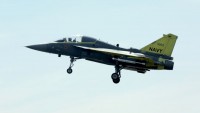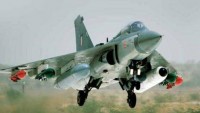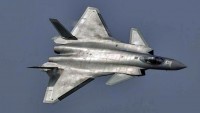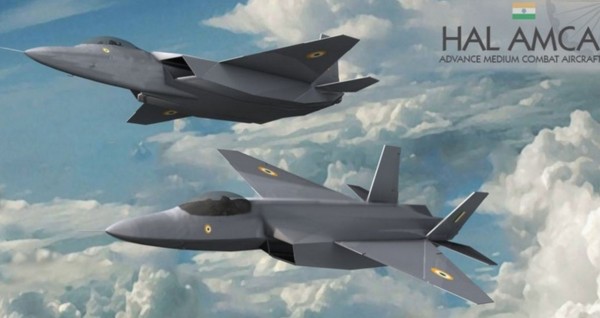India’s Stealth Fighter will be Superior to China’s J-20 and Russia’s PAK FA T-50; will also Launch BrahMos
| Arthur Dominic Villasanta | | Nov 20, 2016 06:14 AM EST |
(Photo : HAL) HAL's concept for India's stealth fighter.
India's new fifth generation stealth fighter will be superior in key aspects to Russia's PAK FA T-50 from which it's derived, and will also have the added advantage of being able to fire the newest iteration of the fearsome BrahMos cruise missile, the BrahMos NG.
And as the PAK FA is already superior to China's Chengdu J-20 low observable fighter, this means the Indian stealth jet will also be superior to the J-20.
Like Us on Facebook
Indian media reports said India's as yet unnamed stealth fighter will include a total of 43 improvements over the PAK FA T-50, making it superior in many key aspects to the Russian fighter, of which only six have been produced because they cost over $100 million apiece.
That's far too expensive for a battered Russian economy still crippled by Western sanctions triggered by Russia's illegal annexation of the Crimea in 2014.
The Indian stealth fighter will be superior in stealth, supercruise, advanced sensors, networking and combat avionics to PAK FA.
Under a co-development deal, India will develop one prototype while Russia will develop another. The Indian version will be a two-seat fighter manned by a pilot and a Weapon Systems Operator. The Russian version will be a traditional single seat stealth fighter like the Lockheed Martin F-35 Lightning II.
India wants its indigenous stealth fighter jet to become operational with the Indian Air Force before 2025. It plans to build as many as 127 stealth fighters.
India's Fifth Generation Fighter Aircraft (FGFA) project will be developed and produced by the Hindustan Aeronautics Limited (HAL) at its facility in Nashik at an estimated cost of $25 billion.
"The agreement has been completed on our end; we are ready to sign it. It is now down to the Indian side. There are some formalities to figure out, but I think it will be signed by the end of this year," said Sergei Chemezov, CEO of Russian weapons maker Rostech Corporation.
Chemzov noted the project "will produce a state of the art fighter jet, and it will be the result of the work on Russia's most modern technology done by both Russian and Indian engineers. As fifth generation, it means fifth generation speed, ballistics and military equipment, avionics and stealth capabilities among other qualities."
A significant advantage to the Indian stealth fighter will be its ability to loft and launch BrahMos-NG (Next Generation), a lighter, smaller but deadlier version of the original BrahMos built to destroy enemy warships.
Also called mini-BrahMos, this new version will be 50 percent lighter than the original version but will be just as fast at Mach 3.5 (4,300 km/h). Expected to become operational after 2018, BrahMos-NG will have a far smaller radar cross section or RCS than its predecessor, making it far more difficult to locate and destroy.
BrahMos-NG will arm the Indian Air Force's Sukhoi Su-30MKI air superiority fighter; Mikoyan MiG-29K carrier-based multirole fighter; HAL Tejas Light Attack Fighter for land and carrier use and the Dassault Rafale multirole fighter, of which 36 have been purchased by India.
The SU-30MKI will be able to carry three BrahMos-NGs while the other combat aircraft will carry one each. It's not known how many BrahMos-NGs India's new stealth fighter will carry.
TagsIndia, stealth fighter, Fifth Generation Fighter Aircraft (FGFA) project, PAK FA T-50, Chengdu J-20, BrahMos, BrahMos NG, cruise missile
©2015 Chinatopix All rights reserved. Do not reproduce without permission
 Indian Navy Buying Three EMALS Catapults for Future Supercarriers, Including INS Vishal
Indian Navy Buying Three EMALS Catapults for Future Supercarriers, Including INS Vishal New Tejas Fighter/Attack Jet will Equip INS Vishal Supercarrier and INS Vikrant Carrier
New Tejas Fighter/Attack Jet will Equip INS Vishal Supercarrier and INS Vikrant Carrier India set to Acquire 100 Avenger Armed Aerial Drones from the US
India set to Acquire 100 Avenger Armed Aerial Drones from the US India Acquires 83 ‘Tejas’ Fighter/Attack Jets with Stealth Features for the Indian Air Force
India Acquires 83 ‘Tejas’ Fighter/Attack Jets with Stealth Features for the Indian Air Force Indian Air Force Derides Alleged ‘Stealth’ Capabilities of China’s J-20 Jet
Indian Air Force Derides Alleged ‘Stealth’ Capabilities of China’s J-20 Jet
EDITOR'S PICKS
-

Did the Trump administration just announce plans for a trade war with ‘hostile’ China and Russia?
-

US Senate passes Taiwan travel bill slammed by China
-

As Yan Sihong’s family grieves, here are other Chinese students who went missing abroad. Some have never been found
-

Beijing blasts Western critics who ‘smear China’ with the term sharp power
-

China Envoy Seeks to Defuse Tensions With U.S. as a Trade War Brews
-

Singapore's Deputy PM Provides Bitcoin Vote of Confidence Amid China's Blanket Bans
-

China warns investors over risks in overseas virtual currency trading
-

Chinese government most trustworthy: survey
-

Kashima Antlers On Course For Back-To-Back Titles
MOST POPULAR
LATEST NEWS
Zhou Yongkang: China's Former Security Chief Sentenced to Life in Prison

China's former Chief of the Ministry of Public Security, Zhou Yongkang, has been given a life sentence after he was found guilty of abusing his office, bribery and deliberately ... Full Article
TRENDING STORY

China Pork Prices Expected to Stabilize As The Supplies Recover

Elephone P9000 Smartphone is now on Sale on Amazon India

There's a Big Chance Cliffhangers Won't Still Be Resolved When Grey's Anatomy Season 13 Returns

Supreme Court Ruled on Samsung vs Apple Dispute for Patent Infringement

Microsoft Surface Pro 5 Rumors and Release Date: What is the Latest?










